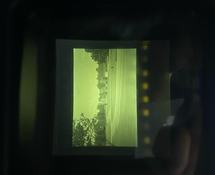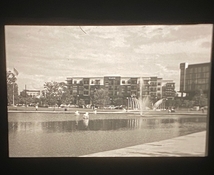Pentaxian
Member
I've recently gotten back in to photography. So far, I've shot two rolls of Rollei 80s film and reversal processed them. The second roll turned out a tad better, but I've still got to work out some issues with the process.
Problem one: The shadowed areas in some shots are clear. They look how you'd expect shadows to look if the film was processed as a negative. The rest of the image turned out how you'd want reversal processed film to turn out: as a positive image. I bracketed exposures, and the clear shadows are much more prevalent in the underexposed slides.
Problem two: The contrast seems to be a bit too low, The mid tones seem muddy to me. Highlights might be a tad too dark, too.
Problem three: There seems to be a bit of fog in the film.
I feel like nailing down the exposure is the solution to Problem One. Maybe there's not enough exposure in the shadows and what is there is lost during the bleach bath, leading to clear shadows instead of dark shadows
Would Problem Two be a developing issue? Develop longer to increase contrast?
Problem Three might be the developer? My first roll was worse, and I thought it might have been fogging from not being in a perfectly dark room while loading my film tank (after my eyes adjusted to the darkness, I could see a tad bit of light seeping in around the door). For roll 2, I used a different bathroom at night, and I could see no light seeping through the door even after my eyes adjusted. The fog exists on roll 2, as well, though
Step 2: First Developer. I used Dektol 1:10. Continuous agitation for 10 minutes
Step 3: Stop bath for 1 minute
Step 4: Water Rinse. Fill enough water to cover the film and let it sit for 1 minute
Step 5: Bleach. Potassium permangante and sodium bisulfate for 4 minutes
Step 6: Rinse (same as step 4)
Step 7: Clear Bath. Sodium Metabisulfite for 2 minutes
Step 8: Rinse (same as step 4)
Step 9: Re exposure. Take film out of the film tank and hold the reel to the light for 5 minutes. I rolled and flipped the film around the entire time. Light source was LED bulbs in the restroom. Not sure of the lumens, but (iirc), they are 40 watt equivalent bulbs. I might have another box hiding somewhere in the house, and I'll look for it and check for sure
Step 10: Second developer. Dektol 1:2 for 3 mins with constant agitation
Step 11: Rinse (same as step 4)
Step 12: Fixer. LegacyPro fixer. 5 mins, with agitation for 10 seconds at the start of each minute
Step 13: Wash. Fill tank with water, agitate a bit, dump. Repeated multiple times
Step 14: Rinse aid solution
Step 15: dry, inspect, and mount (assuming there's any worth mounting )
)
Edit (forgot to attach images): One is an underexposed shot showing clear shadows. Second is a pic of a different shot from the roll in a little slide viewer.
Problem one: The shadowed areas in some shots are clear. They look how you'd expect shadows to look if the film was processed as a negative. The rest of the image turned out how you'd want reversal processed film to turn out: as a positive image. I bracketed exposures, and the clear shadows are much more prevalent in the underexposed slides.
Problem two: The contrast seems to be a bit too low, The mid tones seem muddy to me. Highlights might be a tad too dark, too.
Problem three: There seems to be a bit of fog in the film.
I feel like nailing down the exposure is the solution to Problem One. Maybe there's not enough exposure in the shadows and what is there is lost during the bleach bath, leading to clear shadows instead of dark shadows
Would Problem Two be a developing issue? Develop longer to increase contrast?
Problem Three might be the developer? My first roll was worse, and I thought it might have been fogging from not being in a perfectly dark room while loading my film tank (after my eyes adjusted to the darkness, I could see a tad bit of light seeping in around the door). For roll 2, I used a different bathroom at night, and I could see no light seeping through the door even after my eyes adjusted. The fog exists on roll 2, as well, though
My reversal Process
Step 1: Rinse with water for 3 mins
Step 2: First Developer. I used Dektol 1:10. Continuous agitation for 10 minutes
Step 3: Stop bath for 1 minute
Step 4: Water Rinse. Fill enough water to cover the film and let it sit for 1 minute
Step 5: Bleach. Potassium permangante and sodium bisulfate for 4 minutes
Step 6: Rinse (same as step 4)
Step 7: Clear Bath. Sodium Metabisulfite for 2 minutes
Step 8: Rinse (same as step 4)
Step 9: Re exposure. Take film out of the film tank and hold the reel to the light for 5 minutes. I rolled and flipped the film around the entire time. Light source was LED bulbs in the restroom. Not sure of the lumens, but (iirc), they are 40 watt equivalent bulbs. I might have another box hiding somewhere in the house, and I'll look for it and check for sure
Step 10: Second developer. Dektol 1:2 for 3 mins with constant agitation
Step 11: Rinse (same as step 4)
Step 12: Fixer. LegacyPro fixer. 5 mins, with agitation for 10 seconds at the start of each minute
Step 13: Wash. Fill tank with water, agitate a bit, dump. Repeated multiple times
Step 14: Rinse aid solution
Step 15: dry, inspect, and mount (assuming there's any worth mounting
 )
)Edit (forgot to attach images): One is an underexposed shot showing clear shadows. Second is a pic of a different shot from the roll in a little slide viewer.
Attachments
Last edited:










